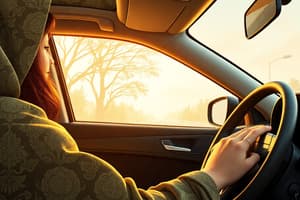Podcast
Questions and Answers
What is the significance of projecting your vision 15 seconds in advance while driving?
What is the significance of projecting your vision 15 seconds in advance while driving?
- It prevents the need to adjust your mirror settings frequently.
- It helps in avoiding disruptions caused by abrupt stops.
- It allows for better reaction time to unforeseen hazards. (correct)
- It ensures that your vehicle's headlights remain operational.
Which action is recommended to avoid drifting while driving?
Which action is recommended to avoid drifting while driving?
- Maintain control of your pivot point. (correct)
- Speed up to overtake slower vehicles.
- Use your turn signals at all times.
- Adjust your rearview mirror regularly.
How can drivers effectively communicate their intentions to others on the road?
How can drivers effectively communicate their intentions to others on the road?
- By making sudden lane changes without signaling.
- By driving at excessive speeds to assert presence.
- By only using hand signals in urban areas.
- Using headlights during the day to be more visible. (correct)
What strategy should drivers use at intersections to anticipate the actions of others?
What strategy should drivers use at intersections to anticipate the actions of others?
What is the purpose of flashing brake lights before slowing down?
What is the purpose of flashing brake lights before slowing down?
What is the recommended following distance when driving under normal conditions?
What is the recommended following distance when driving under normal conditions?
What does the Roll-to-Control technique primarily aim to prevent?
What does the Roll-to-Control technique primarily aim to prevent?
How long should you wait before releasing the brake after the leading vehicle begins to accelerate?
How long should you wait before releasing the brake after the leading vehicle begins to accelerate?
In multi-lane roads, what should you ideally consider when choosing a lane?
In multi-lane roads, what should you ideally consider when choosing a lane?
What is the Point of No Return (PNR) related to?
What is the Point of No Return (PNR) related to?
What should you do when encountering a vehicle stalled ahead?
What should you do when encountering a vehicle stalled ahead?
What is the recommended method after stopping at a red light when it turns green?
What is the recommended method after stopping at a red light when it turns green?
What factor can increase the required following distance beyond the standard 4 seconds?
What factor can increase the required following distance beyond the standard 4 seconds?
What is the recommended frequency for checking your mirrors while driving?
What is the recommended frequency for checking your mirrors while driving?
What does the acronym SMOG stand for in driving safety?
What does the acronym SMOG stand for in driving safety?
What should you do before slowing down your vehicle?
What should you do before slowing down your vehicle?
What is the primary purpose of the Two-Second Eye Movement technique?
What is the primary purpose of the Two-Second Eye Movement technique?
What should you do in LOW visibility scenarios?
What should you do in LOW visibility scenarios?
Which of the following defines 'invaders' in the context of driving?
Which of the following defines 'invaders' in the context of driving?
What technique should you use when approaching an intersection?
What technique should you use when approaching an intersection?
What should you maintain awareness of regarding parked vehicles?
What should you maintain awareness of regarding parked vehicles?
Flashcards
L.I.V.E. Driving System
L.I.V.E. Driving System
A system for safe driving that emphasizes anticipating and reacting to road conditions and other drivers.
Project your vision ahead
Project your vision ahead
Anticipate potential hazards 15 seconds down the road.
Use headlights 24/7
Use headlights 24/7
Maintain visibility to other drivers at all times.
Use turn signals
Use turn signals
Signup and view all the flashcards
Maintain vehicle position
Maintain vehicle position
Signup and view all the flashcards
Eye Movement (Driving)
Eye Movement (Driving)
Signup and view all the flashcards
Two-Second Rule
Two-Second Rule
Signup and view all the flashcards
Mirror Checks (Frequency)
Mirror Checks (Frequency)
Signup and view all the flashcards
Mirror Checks (Before Slowing)
Mirror Checks (Before Slowing)
Signup and view all the flashcards
Mirror Checks (After Stopping)
Mirror Checks (After Stopping)
Signup and view all the flashcards
SMOG Method
SMOG Method
Signup and view all the flashcards
Invaders (Driving)
Invaders (Driving)
Signup and view all the flashcards
Visibility Obstacles (Driving)
Visibility Obstacles (Driving)
Signup and view all the flashcards
4-Second Following Distance
4-Second Following Distance
Signup and view all the flashcards
Roll-to-Control
Roll-to-Control
Signup and view all the flashcards
Space Cushion
Space Cushion
Signup and view all the flashcards
Lane Choice
Lane Choice
Signup and view all the flashcards
Point of No Return (PNR)
Point of No Return (PNR)
Signup and view all the flashcards
Stopping Distance
Stopping Distance
Signup and view all the flashcards
4-Second Rule/Reaction Time
4-Second Rule/Reaction Time
Signup and view all the flashcards
Safe Following Distance
Safe Following Distance
Signup and view all the flashcards



